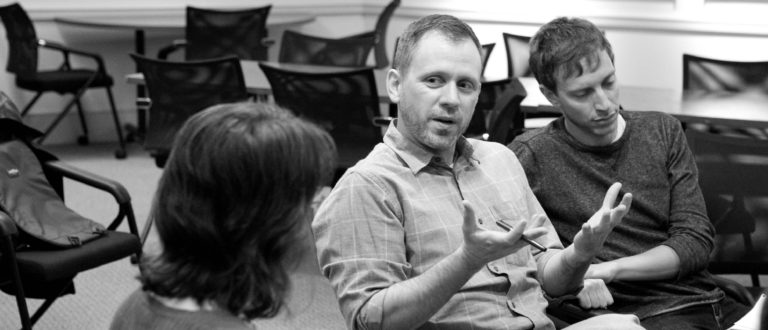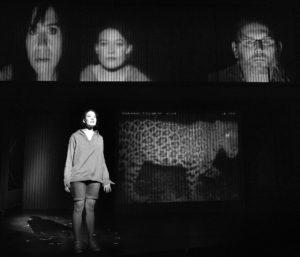This article was originally published in SDC Journal on May 19, 2020.
During the culture wars of the 1990s, when Jesse Helms and his fellow senators objected to using government funds to support artworks they found offensive, their complaints weren’t only about decency and morals. The politicians invoked a battle cry over wasteful spending of taxpayer money—and pointed to cultural grants as a leading example of how public funds shouldn’t be spent. In the decades since, NEA funding and cultural grants have been regularly hauled out by conservative politicians to make their case for cuts.
Steve Cosson, Artistic Director of The Civilians, has had firsthand experience with the scrutiny of politicians and the media over public funding for the arts. In 2010, The Civilians was awarded nearly $700,000 from the National Science Foundation to support the creation of The Great Immensity, a musical written and directed by Cosson, with music and lyrics by Michael Friedman. The Great Immensity is described by the company as “a highly theatrical look into one of the most vital questions of our time: how can we change ourselves and our society in time to solve the enormous environmental challenges that confront us?” The project—which is recognized as the first major American play about climate change—encompassed not just content and script development but also creation of a science-based arts education curriculum and other ancillary programs. It was produced in 2012 with Kansas City Repertory Theatre and in 2014 with The Public Theater in New York City. The cast album was recently released by Ghostlight Records as part of the Michael Friedman Recording Project.
In January 2020—10 years after the grant was made—Cosson spoke with Elizabeth Bennett of SDC Journal about his reflections on the relationship between government and the arts.
Elizabeth Bennet: Let’s go back to the roots where the later hullaballoo over The Great Immensity may have started: the late ‘80s/early ‘90s and the culture wars. What level of awareness did you have about the culture wars and the NEA Four case when it was going on?
Steve Cosson: I was very conscious of it. As my day job when I was in my twenties, I worked as a development professional, writing grant proposals at a nonprofit arts organization in San Francisco. Some of the NEA Four were performers whose work I liked. Holly Hughes performed in San Francisco a lot.
After the case happened, my arts organization wanted to go through its end-of-year journal and edit out anything that was too sexually explicit, especially anything that was somehow not heteronormative.
Editing the journal wasn’t my job, so I didn’t have any power over it. But it was sad to see how easily an arts organization could censor itself. And I remember thinking, “Gosh, why am I feeling so particularly anxious and depressed right now?” And my response was, “Well, I’m a gay man and I work at an arts nonprofit doing fundraising, and right now our federal government is attacking all of those categories on multiple fronts.”
The message from the NEA Four case was anti-gay, anti-sex, and anti-feminist. Or, “We can’t do this horrible thing of supporting artists because then they might make art that we don’t like or makes us uncomfortable.” The scandal of the NEA Four pushed us into a ridiculous circumstance where the NEA cannot fund work by individual artists: NEA money can’t go directly to an artist making art.
Elizabeth: Did you think about taking political action at the time?
Steve: No. It was the early ’90s, and the activism I was involved with had to do with Act Up and Queer Nation. AIDS activism outweighed the arts funding question.
I think Jesse Helms—with his campaign against Mapplethorpe and any AIDS education that would “promote homosexuality”—was a true believer in his cause. He did not believe that gay men had equal value as human beings. My favorite quote from the culture wars was in Jesse Helms’s Senate testimony. He showed some of the Mapplethorpe photos to his wife, Dorothy, and she said, “Oh, Lord have mercy, Jesse. I am not believing this.”
Elizabeth: That would make a great title for a play.
Steve: It always made me think, “Well, no. Somebody like Jesse Helms’s wife is not supposed to be looking at a picture of Robert Mapplethorpe sticking a whip up his ass.” We have very different people living in this country together and those two people might not cross paths. The government should fund a museum that can put on that show and Mrs. Helms is probably not going to walk into that museum. Her husband and his own personal tastes should just not be involved.
Elizabeth: Given your familiarity with the history, how did you feel in 2014 when Congressman Lamar Smith pointed to The Civilians’ National Science Foundation grant as an example of wasteful government funding?

Steve: I was not particularly surprised. I had seen those tactics used for decades, particularly by Republicans, as a tool to try to go after programs. It’s a tactic we’re all very familiar with: cherry-picking something and holding it up in front of Congress to be used as an example to say, “Look at all the terrible things that happen if you vote for the other party.”
There were three phases of life for The Great Immensity when the project was called out: when the grant was first announced, when we did our first production with Kansas City Rep, and then the second production with The Public Theater. Over the whole life of The Great Immensity, it felt as though the conservative media and certain members of Congress were trying to make it into “a thing,” but it never fully took off. There was just so much going on in the world that, fortunately, it didn’t become a huge source of outrage in the national media.
Every time a right-wing news story or blog piece appeared about it, there would be several hundred comments. That’s certainly true of anything about climate change in that climate change has successfully been made such a politicized issue and—like so many other things in that category—it’s troll bait. There’s a world of people out there that, if there’s an opportunity to make a comment on the internet, they will find a way to do so.
I don’t know if, in their hearts, the Republicans actually oppose the projects but they think that going after these targets will curry favor with their supporters. Not to say that I have insight into the inner workings of their minds, but I think that part of it is truly about getting publicity.
It also serves the Republican ideology—if not their practice—that they are a party that believes in “small government” and will maintain your liberty and freedom by keeping the government small and out of your life. They will not waste taxpayer money. Of course, I think there’s an argument that what the party does is not consistent with that ideology or the PR version of their politics.
Elizabeth: How did you respond to Representative Smith or to the news coverage?
Steve: We were in conversations with the National Science Foundation throughout all of this and their advice was that we just let it go. They didn’t want to draw more attention; they had been to this party before. The “waste book” is something that I think happens every year, and part of that is combing through the National Science Foundation grants to find the things that might sound ridiculous.
Much later, Mick Mulvaney—then the budget director for Trump—cited the grant in a press conference as way to say that the Trump administration would not be funding climate science. I wrote an op-ed, which got placed on CNN.com. [Editor’s Note: In a June 2017 interview with CNN, Cosson draws analogies between the Trump administration’s “willful denial of climate change” and its desire to cut federal arts funding by 87 percent, pointing out that it’s not just the arts that are under attack from the right wing.]
Throughout it all, I got a taste of what it’s like to be on the receiving end of a right-wing media campaign. Congressman Eddie Bernice Johnson argued that Lamar Smith leaked our confidential grant reports to Fox News, who then spun certain details in a negative light. (These were details that later resurfaced at the Washington Post and other mainstream media.) Over the years, I got easily more than 150 Google alerts about some new piece decrying this terrible grant and saying that I’m a bad artist, my play was terrible and it closed early (which was not true), and various other things that they made up. And the day after one Fox News piece, our education site for the project and The Civilians’ website got hacked and taken out.
Maybe if we had been defunded like the NEA Four were, then there would have been articles supporting the project. But we were being attacked for keeping our funding. The tone of the mainstream reporting, although much smaller than the right-wing response, leaned towards the same framing: the grant was excessive and wasteful. There really wasn’t much of a public voice of support. There were years of attack articles, on top of being attacked by members of Congress. And yes, we kept our funding, and I’m very grateful for that. But it was an intimidating and demoralizing experience. We got hit by the massive machine the right has at its disposal, from Congress to Fox to the troll army, whereas on the other side…
Elizabeth: We could go down a rabbit hole of what that commentary is on the liberal media.
Steve: What happened, ultimately and unfortunately, is that the negative story reached a lot of viewers. The message got out to a large number of people that the government engaged in ridiculous wasteful spending on both the arts and science. I venture to guess that the National Science Foundation would be very cautious now to fund anything that could be considered an artistic project.
And the grant was weaponized against climate science. To go back to that moment in 2017, several years after the grant finished, when the press asked Mick Mulvaney if Trump’s budget was going to include funding for climate science, his response was, “What the government did the last time when they funded climate science, they funded a musical. I know you don’t want that to happen with your tax dollars.”
Elizabeth: Is it fair to assume that the National Science Foundation funding was essential to creating the piece and that The Civilians might not have done it otherwise?
Steve: The National Science Foundation funding was critical to the play being done but also being done well.
This was one of the most significant theatre projects that they had funded through that program. We accompanied both productions with a whole array of educational tools. There’s a website with all types of information that could be shared with the audience. There was a curriculum for the school groups that would come to see it. There were events at the theatres, lots of post-show programs.
There was also—and this was a very important part of the funding for the NSF—a significant amount of money to study the efficacy of theatre to serve as informal science education. I probably spoke on 20 different panels about theatre and climate change over the years. An evaluator surveyed audience members, surveyed users in any way that we might interface with the public, worked with the project over the several years of its life span, and then wrote a very detailed report on her research.
Elizabeth: That’s a lot of energy to put into it as a creator and artistic director.
Steve: Well, that was the project. The education and the evaluation elements were as important as the play itself.
The funding was very generous in that it was a significant amount of money and it paid for all that additional work. It paid for a portion of each production; both Kansas City Rep and The Public also contributed to the productions.
Elizabeth: The scale of the grant size is so much greater than those of us working in the arts are accustomed to.
Steve: A lot of arts funding is almost like the performance of arts funding. Everyone is going through the motions as if there was funding happening: “We’re doing this proposal. There are a lot of people doing a lot of work to read the proposals and there’s this work being done to report on the grants.” But often there isn’t any real money moving about in a meaningful way.
The size of our NSF grant was an effective political tool. It sounds like a lot of money because it is a lot of money. If you don’t work in theatre and you hear somebody got $700,000 for a play, that might sound insane. Whereas to do a play with music, one production, in an Off-Broadway, nonprofit theatre in New York City with 199 seats, that can be $700,000. It can also be a lot more. Our grant supported three years of work, contributed to two productions, plus the education and evaluation, with everyone earning normal nonprofit theatre money (i.e., not that much).
Elizabeth: Where do you see the responsibility of not just leaders of theatre companies but also workers at arts organizations? What’s our responsibility at this point in time?
Steve: That is a very big question. On the most basic level, our responsibility is to try as best as we can to live and work in the world as it actually is. That may entail putting in some effort to discern where and how you might be living within a certain kind of bubble—and then figuring out strategies for how you might challenge that and somehow make the scope of your work wider.
Another broad-strokes response is a desire for theatre institutions and for theatremakers to work from a place of courage rather than fear. I think in many ways we are used to working from courage. Just to make any kind of theatre and to put it up in the world—to take that risk requires courage.
But I think that the more challenging, essential piece is the fear we have of running out of money. The funding is going to get pulled or people aren’t going to buy tickets, or the important people who buy tickets and give money are going to be upset or whatever it might be.
That fear is oftentimes very valid. We don’t have the kind of government subsidy that offers the stability that theatres in other developed countries have, where you can weather the ups and downs of ticket sales or take a risk on something that may or may not pan out.
So, I don’t mean to discount the fear. It’s real. I also run an organization and have to deal with the consequences of choices. If you make a choice that then hurts your bottom line, it threatens your livelihood and your ability to do the work that you’re supposed to be doing.
But even though the economic fears are real, I think they can contribute to a vicious cycle of neglecting to engage in all sorts of really meaningful aspects of life—thereby, in the worst-case scenario, guaranteeing the irrelevance of your art form.
Elizabeth: Because it’s too safe.
Steve: Because it’s too safe. Yeah.
Elizabeth: One of the things that I am concerned about is whether the fear of losing funding is a form of censorship.
Steve: No theatre really has absolute freedom of speech. It’s a given that it is going to be curtailed in some way by the beliefs of what’s acceptable and who might buy tickets and support the institution. It’s a balancing act.
At the same time, there are certainly a lot of risky plays getting produced now, which is exciting. Of course, there are certain kinds of risks that are acceptable and others that are not. At any given moment, certain plays that challenge on issues of race, class, sexuality, geopolitics, or whatever will be acceptable and others will not be. I think that’ll always be the case. So, it will always be a matter of trying to push the goalposts further along.
But I think there’s value in those companies and artists or institutions—big or small—that have the capacity to widen the aperture in whatever way they can. That work is valuable and it affects the whole landscape.
Elizabeth: What was your reaction to the recent announcement that not only would the NEA not be shut down in 2020—as the president had threatened—but that the budget was increased to $162 million?
Steve: The more NEA budget, the better. But I think we should all pay attention to how that money is spent and what kind of work it supports. The more we know, the better.
Author
-

The Civilians is a company that creates new theater from creative investigations into the most vital questions of the present. Through a number of artistic programs, the Civilians advances theater as an engine of artistic innovation and strengthens the connections between theater and society. An artist-led company, the Civilians creates and produces new theater and pursues its artistic mission through programs serving artists and the public. The company’s work is grounded in investigative theater, an artistic practice rooted in the process of creative inquiry that brings artists into dynamic engagement with the subject of their work. Artists look outward in pursuit of a question, often engaging with individuals and communities in order to listen, make discoveries, and challenge habitual ways of knowing. The ethos of investigative theater extends into production, inviting audiences to be active participants in the inquiry before, during, and after the performance. Since its founding in 2001, the Obie Award-winning company has supported the creation of 14 original shows, and its work has been produced at many theaters in New York, nationally, and internationally. Last season saw two highly successful shows: "Mr. Burns: a Post-Electric Play" at Playwrights Horizons, which was included in eight Top 10 of 2013 Lists, and "The Great Immensity" at The Public Theater. The Civilians’ work has been published by Dramatists Play Service, Oberon Books, Ghostlight Records and Playscripts, Inc.
View all posts









